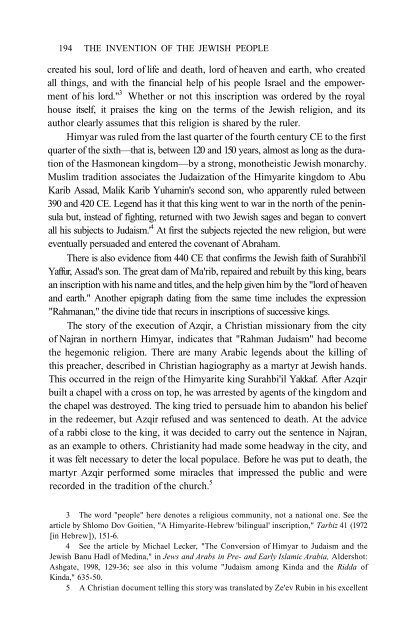Shlomo Sand, The Invention of the Jewish People - Rafapal
Shlomo Sand, The Invention of the Jewish People - Rafapal
Shlomo Sand, The Invention of the Jewish People - Rafapal
Create successful ePaper yourself
Turn your PDF publications into a flip-book with our unique Google optimized e-Paper software.
194 THE INVENTION OF THE JEWISH PEOPLE<br />
created his soul, lord <strong>of</strong> life and death, lord <strong>of</strong> heaven and earth, who created<br />
all things, and with <strong>the</strong> financial help <strong>of</strong> his people Israel and <strong>the</strong> empowerment<br />
<strong>of</strong> his lord." 3 Whe<strong>the</strong>r or not this inscription was ordered by <strong>the</strong> royal<br />
house itself, it praises <strong>the</strong> king on <strong>the</strong> terms <strong>of</strong> <strong>the</strong> <strong>Jewish</strong> religion, and its<br />
author clearly assumes that this religion is shared by <strong>the</strong> ruler.<br />
Himyar was ruled from <strong>the</strong> last quarter <strong>of</strong> <strong>the</strong> fourth century CE to <strong>the</strong> first<br />
quarter <strong>of</strong> <strong>the</strong> sixth—that is, between 120 and 150 years, almost as long as <strong>the</strong> duration<br />
<strong>of</strong> <strong>the</strong> Hasmonean kingdom—by a strong, mono<strong>the</strong>istic <strong>Jewish</strong> monarchy.<br />
Muslim tradition associates <strong>the</strong> Judaization <strong>of</strong> <strong>the</strong> Himyarite kingdom to Abu<br />
Karib Assad, Malik Karib Yuharnin's second son, who apparently ruled between<br />
390 and 420 CE. Legend has it that this king went to war in <strong>the</strong> north <strong>of</strong> <strong>the</strong> peninsula<br />
but, instead <strong>of</strong> fighting, returned with two <strong>Jewish</strong> sages and began to convert<br />
all his subjects to Judaism.' 4 At first <strong>the</strong> subjects rejected <strong>the</strong> new religion, but were<br />
eventually persuaded and entered <strong>the</strong> covenant <strong>of</strong> Abraham.<br />
<strong>The</strong>re is also evidence from 440 CE that confirms <strong>the</strong> <strong>Jewish</strong> faith <strong>of</strong> Surahbi'il<br />
Yaffur, Assad's son. <strong>The</strong> great dam <strong>of</strong> Ma'rib, repaired and rebuilt by this king, bears<br />
an inscription with his name and titles, and <strong>the</strong> help given him by <strong>the</strong> "lord <strong>of</strong> heaven<br />
and earth." Ano<strong>the</strong>r epigraph dating from <strong>the</strong> same time includes <strong>the</strong> expression<br />
"Rahmanan," <strong>the</strong> divine tide that recurs in inscriptions <strong>of</strong> successive kings.<br />
<strong>The</strong> story <strong>of</strong> <strong>the</strong> execution <strong>of</strong> Azqir, a Christian missionary from <strong>the</strong> city<br />
<strong>of</strong> Najran in nor<strong>the</strong>rn Himyar, indicates that "Rahman Judaism" had become<br />
<strong>the</strong> hegemonic religion. <strong>The</strong>re are many Arabic legends about <strong>the</strong> killing <strong>of</strong><br />
this preacher, described in Christian hagiography as a martyr at <strong>Jewish</strong> hands.<br />
This occurred in <strong>the</strong> reign <strong>of</strong> <strong>the</strong> Himyarite king Surahbi'il Yakkaf. After Azqir<br />
built a chapel with a cross on top, he was arrested by agents <strong>of</strong> <strong>the</strong> kingdom and<br />
<strong>the</strong> chapel was destroyed. <strong>The</strong> king tried to persuade him to abandon his belief<br />
in <strong>the</strong> redeemer, but Azqir refused and was sentenced to death. At <strong>the</strong> advice<br />
<strong>of</strong> a rabbi close to <strong>the</strong> king, it was decided to carry out <strong>the</strong> sentence in Najran,<br />
as an example to o<strong>the</strong>rs. Christianity had made some headway in <strong>the</strong> city, and<br />
it was felt necessary to deter <strong>the</strong> local populace. Before he was put to death, <strong>the</strong><br />
martyr Azqir performed some miracles that impressed <strong>the</strong> public and were<br />
recorded in <strong>the</strong> tradition <strong>of</strong> <strong>the</strong> church. 5<br />
3 <strong>The</strong> word "people" here denotes a religious community, not a national one. See <strong>the</strong><br />
article by <strong>Shlomo</strong> Dov Goitien, "A Himyarite-Hebrew 'bilingual' inscription," Tarbiz 41 (1972<br />
[in Hebrew]), 151-6.<br />
4 See <strong>the</strong> article by Michael Lecker, "<strong>The</strong> Conversion <strong>of</strong> Himyar to Judaism and <strong>the</strong><br />
<strong>Jewish</strong> Banu Hadl <strong>of</strong> Medina," in Jews and Arabs in Pre- and Early Islamic Arabia, Aldershot:<br />
Ashgate, 1998, 129-36; see also in this volume "Judaism among Kinda and <strong>the</strong> Ridda <strong>of</strong><br />
Kinda," 635-50.<br />
5 A Christian document telling this story was translated by Ze'ev Rubin in his excellent




